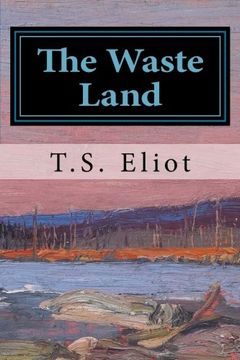Reseña del libro "The Waste Land (en Inglés)"
The Waste Land is a long poem by T. S. Eliot, widely regarded as one of the most important poems of the 20th century and a central work of modernist poetry. Published in 1922, the 434-line poem first appeared in the United Kingdom in the October issue of The Criterion and in the United States in the November issue of The Dial. It was published in book form in December 1922. Among its famous phrases are "April is the cruellest month", "I will show you fear in a handful of dust", and the mantra in the Sanskrit language "Shantih shantih shantih". Eliot's poem loosely follows the legend of the Holy Grail and the Fisher King combined with vignettes of contemporary British society. Eliot employs many literary and cultural allusions from the Western canon, Buddhism and the Hindu Upanishads. Because of this, critics and scholars regard the poem as obscure. The poem shifts between voices of satire and prophecy featuring abrupt and unannounced changes of speaker, location, and time and conjuring of a vast and dissonant range of cultures and literatures. The Waste Land's structure is divided into five sections. The first section, "The Burial of the Dead," introduces the diverse themes of disillusionment and despair. The second, "A Game of Chess," employs vignettes of several characters—alternating narrations—that address those themes experientially. "The Fire Sermon," the third section, offers a philosophical meditation in relation to the imagery of death and views of self-denial in juxtaposition influenced by Augustine of Hippo and eastern religions. After a fourth section, "Death by Water," which includes a brief lyrical petition, the culminating fifth section, "What the Thunder Said," concludes with an image of judgment. Eliot probably worked on the text that became The Waste Land for several years preceding its first publication in 1922. In a May 1921 letter to New York lawyer and patron of modernism John Quinn, Eliot wrote that he had "a long poem in mind and partly on paper which I am wishful to finish".[5] Richard Aldington, in his memoirs, relates that "a year or so" before Eliot read him the manuscript draft of The Waste Land in London, Eliot visited him in the country.[6] While walking through a graveyard, they discussed Thomas Gray's Elegy Written in a Country Churchyard. Aldington writes: "I was surprised to find that Eliot admired something so popular, and then went on to say that if a contemporary poet, conscious of his limitations as Gray evidently was, would concentrate all his gifts on one such poem he might achieve a similar success."[6] Eliot, having been diagnosed with some form of nervous disorder, had been recommended rest, and applied for three months' leave from the bank where he was employed; the reason stated on his staff card was "nervous breakdown". He and his first wife, Vivienne Haigh-Wood Eliot, travelled to the coastal resort of Margate, Kent, for a period of convalescence. While there, Eliot worked on the poem, and possibly showed an early version to Ezra Pound when, after a brief return to London, the Eliots travelled to Paris in November 1921 and stayed with him. Eliot was en route to Lausanne, Switzerland, for treatment by Doctor Roger Vittoz, who had been recommended to him by Ottoline Morrell; Vivienne was to stay at a sanatorium just outside Paris. In Hotel Ste. Luce (where Hotel Elite stands since 1938) in Lausanne, Eliot produced a 19-page version of the poem.[7] He returned from Lausanne in early January 1922. Pound then made detailed editorial comments and significant cuts to the manuscript. Eliot later dedicated the poem to Pound.

